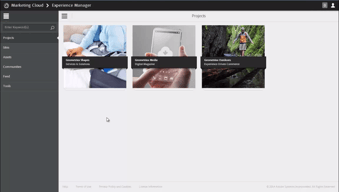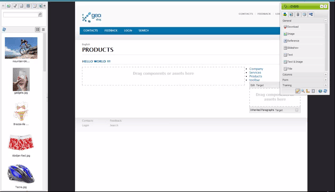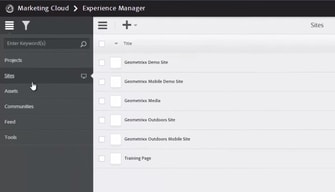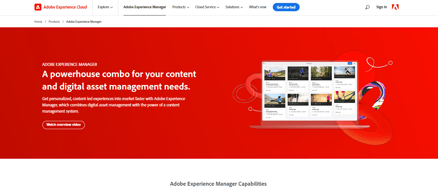

Unclaimed: Are are working at Adobe Experience Manager ?
Adobe Experience Manager Reviews & Product Details
Adobe Experience Manager is a cloud-based content management solution to help businesses create websites, mobile applications, and web forms. The AI-enabled platform lets content creators create, manage, and deliver marketing content to customers using machine learning algorithms. Additionally, it enables content designers to create, modify or publish web pages using the in-context WYSIWYG interface and drag-and-drop functionality.


| Capabilities |
|
|---|---|
| Segment |
|
| Deployment | Cloud / SaaS / Web-Based, On-Premise Linux, On-Premise Windows |
| Support | 24/7 (Live rep), Chat, Email/Help Desk, FAQs/Forum, Knowledge Base, Phone Support |
| Training | Documentation |
| Languages | English |




Compare Adobe Experience Manager with other popular tools in the same category.

It is very adaptable to the customer's requirements by customizing. It is easy to develop in customizing, as there are many references for customizations. The codes of ACS Commons are helpful and easy to learn.
The lice cost is expensive for small users. The big company customers are eligible for AEM, but they are not so aggressive.
It's very adaptable to the customer's requirements.
Asset management is a best thing I can say, one robust tool with multiple integration like target analytics, audiance manger, social media what not.
Long refresh time after adding the components.
Experience fragments do wonders as we can update multiple pages by updating one EF
What I like best about AEM is that you can quickly update the components.
It sometimes takes a while before the AEM loads completely.
When there's a need to update the content of the website, AEM helps in allowing its users to apply the necessary builds right away.
Pick and drop pictures, easy to use, will get an immediate overview after changes happen
Guidelines are not user friendly, for instance, using an experience fragment and template can achieve the same goal, it is not clear to know the impact
One site can manage multiple brand in different countries
Adobe Experience Manager (AEM) is probably the best content management platform being used by Marketing teams. AEM provides more control in the hands of Marketeers to make updates and roll out changes to the live site without any dependency on the development team. Thus making time to market much shorter.
Though AEM has many good features, the platform comes at a cost, it is not the best CMS platform for small and mid-size organizations. Not every organization can afford the initial investment in AEM license costs.
There are multiple problems solved using AEM. 1. Time to market 2. Dependency on development teams 3. Replication of same content for multiple websites - content can be updated at one source and the updates can be reflected at multiple websites or different pages of the same website. 4. Customization of website - AEM provides production-ready core components
I like the easy-to-use drag-and-drop interface and pre-created templates that are available the most.
I don't have any dislikes at the moment.
We were using the Adobe Experience Manager to build and manage the company website.
I like that Adobe is one of the most top-notch and best performing products on the market. It allows for more flexibility with their products and provide some of the best training experiences.
It can be complex based on how the CMS is built surrounding the company and their required specs for it, and if you don't have any familiarity with high-functioning HTML, it will be very hard to grasp and understand.
The business problems I solved with Adobe Experience Manager were high-level experiences for a developing team to help with a newly designed website, along with content migration.
It is one stop solution for all the content, digital and cloud management services.
Issues while dealing with excel format docs.
Quick viewing of pre built reports.
AEM gives marketers the tools needed to take control of the organization's marketing website. No longer do you need an IT request with a 4 week lead time to get site changes made. AEM allows changes to be made in days instead of weeks.
The platform can be laggy and crashes often and usability depends on your organization's custom implementation.
With an in-house CMS it takes weeks to implement changes to a marketing site. With AEM these changes can be implemented in a day.
I love Adobe Experience Manager, with it we can manage digital strategies as experts, its performance is magnificent. I like your website because it has well-distributed content, in addition to having enough specifications. I can establish good relationships with my clients, in addition to being able to schedule specific meetings with them. Adobe Experience Manager is a very robust and complex product to maneuver completely, however, when you adapt to it you can enjoy its diverse characteristics.
A specific aspect that does not satisfy me completely is that Adobe Experience Manager is not very compatible with third-party tools, you will have to have another range of Adobe products. Therefore their costs tend to be higher.
One of the greatest benefits has been the increase of communication with our customers, this has created a significant increase in our sales. On the other hand we have a better design management for our web pages, also we can design them in a shorter time.





